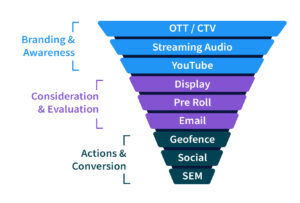How to set digital advertising goals for your business
May 6, 2025
How should your business determine realistic goals for digital advertising? It’s about being smart, strategic and analyzing where you can succeed. Whether you’re advertising for the first time or looking to optimize your existing strategy, here’s how to set digital advertising goals that grow your business.

Understand digital advertising
It’s good to know the various types of digital advertising and how they can each be tailored to meet your specific business goals and objectives. Explore some of the top digital advertising tactics designed to help you grow your business and reach new customers:
Search Engine Marketing (SEM): Drive qualified leads to your website from customers who are ready to take action with Google search advertising.
Best for:
Driving leads
Increasing website traffic
Special promotions
Combines well with:
Display
Social
Targeting includes:
Geography
Keywords
Display: Serve graphic ads to encourage customers to take a specific action or raise brand awareness.
Best for:
Reach and frequency
Combines well with:
SEM
Retargeting
Targeting includes:
Geography
Demographics
Interests
Keywords
Geofence: Deliver location-based ads to mobile customers situated within a specific geographic radius.
Best for:
Hyper-targeted geographies
Combines well with:
Display
Targeting includes:
Geography
Recency (tracking for up to 30 days after leaving location)
Competitor locations
OTT/Over-the-top: Target ads to a streaming audience on any device, but primarily on televisions.
Best for:
Broad audiences
Combines well with:
SEM
Display
Targeting includes:
Geography
Interests
Demographics
CTV/Connected TV: Drive ads to a streaming audience exclusively on televisions.
Best for:
Broad audiences
Combines well with:
SEM
Display
Targeting includes:
Geography
Interests
Demographics
Pre Roll: Serve ads that automatically play directly before the audience starts watching a featured video on desktop, mobile or tablet.
Best for:
Hyper-targeted audiences
Combines well with:
Display
OTT
CTV
Retargeting
Targeting includes:
Geography
Interests
Demographics
- Keywords
YouTube: Target a custom audience in a relevant location with video advertising.
Best for:
Broad audiences
Reach and frequency
Educational content
Combines well with:
Social
Display
Targeting includes:
Geography
Interests
Demographics
Streaming Sports: Deliver ads to sports enthusiasts on streaming television and other devices.
Best for:
Audiences passionate about what they are watching
Combines well with:
SEM
Display
Targeting includes:
Geography at the zip code level
Streaming Audio: Target a streaming audience listening to audio content in a relevant location.
Best for:
Audiences who can’t be reached visually
Combines well with:
Social
SEM
Traditional radio
Retargeting
Targeting includes:
Geography
Social: Serve social media users browsing content using first-party demographics focusing on a relevant location.
Best for:
Brand awareness
Generating leads
Promotions and events
Sales initiatives
Combines well with:
Display
Streaming audio
Retargeting
Targeting includes:
Geography
Interests

Know your audience
Who are your customers? What advertising channels do they use most? When are they most active? Understanding your audience helps you set goals for the right ad platforms and formats. For example, if Gen Z is your target market, you should invest in video ads for social media as it’s the best way to reach this demographic and increase engagement.
Determine resources
Do you have a clear understanding of your advertising budget? Be sure to assess and establish a realistic budget that aligns with the resources you have available to invest in advertising. Prioritize your budget based on the potential return on investment to maximize the effectiveness of your advertising efforts. Consider factors such as audience reach, conversion rate goals and advertising objectives when allotting funds to various advertising channels and tactics. By carefully planning and managing your advertising budget, you’ll optimize your marketing strategy and achieve greater profitability.
Set clear goals
What overarching goals have you set for your business? Are you wanting to increase brand awareness, drive online sales or increase foot traffic to a physical place? To ensure your advertising will achieve the desired results, your goals require different advertising approaches with their own success measures.
As digital advertising is dynamic, meaning algorithms change and customer behaviors shift, your goals can quickly become outdated or irrelevant. Leave room for flexibility with your goals and adapt to what’s happening in marketing overall.

Tools to develop your goals
There are resources available to assist you in defining and mapping out your advertising goals. Use these resources to create a strategic approach to your advertising efforts, confirming that your advertising aligns with your overall business objectives and reaches your customer.
SMART goals
When it comes to driving growth in your business, aligning your digital advertising with SMART goals is essential.
SMART stands for:
Specific: Your ad goals must be clear and specific.
Measurable: Make your ad goals measurable to track performance.
Achievable: Develop modest goals and scale up as your ads gain traction.
Relevant: Tie your ad goals to your overall business plan.
Time-bound: Establish clear timelines with a sense of urgency.
Sales funnel
Build a stronger sales funnel by matching your goals with each stage of the customer journey.
Top of funnel: As the branding and awareness stage, this is where every potential customer begins. The best tactics to engage are OTT/CTV, streaming audio and YouTube.
Middle of funnel: The consideration and evaluation stage builds a relationship with your potential customers by engaging them and building trust. Preferred tactics include display, pre roll and email.
- Bottom of funnel: Action and conversion stage is where your customer decides whether or not to purchase your products and services. Effective tactics include geofence, social and SEM.
Focus on metrics
Choose the metrics that matter most to your goals. Tracking the right data helps you make smarter decisions and improve your advertising results. You’ll need to monitor performance regularly and be ready to adjust your advertising. And remember, you don’t need to track everything, but instead focus on what drives real impact. For example, impressions mean little without engagement, and click-through rates don’t count if customers don’t convert.
Partner with experts
Take advantage of partnering with Forum Communications Company for expert digital advertising strategy and insights. We provide:
Advanced analytics and insights: You have access to data tracking and analysis tools and we’ll help you interpret the results. This is important for developing and improving strategies, segmenting your audience, measuring ROI and understanding customer behavior.
Time and resource efficiency: You’ll benefit from a team of experts managing all aspects of your campaigns so you can focus on your business. And your entire budget goes to advertising as there are no hidden fees or creative costs.
Scalability and flexibility: We’ll scale your advertising to meet your business needs. This ensures your efforts are always aligned with your business goals, adapting to changes in the market and your business.
Setting realistic digital advertising goals is about being practical and strategic. Clear, achievable goals give you direction, make your results measurable and help your business grow. Start smart, track what’s important and adjust as you learn.
Don’t forget to sign up for our newsletter or download our advertising whitepapers for more insights like these delivered straight to your inbox. And follow us on LinkedIn for more valuable advertising trends and tips.
